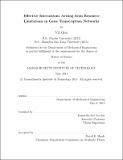| dc.contributor.advisor | Domitilla Del Vecchio. | en_US |
| dc.contributor.author | Qian, Yili | en_US |
| dc.contributor.other | Massachusetts Institute of Technology. Department of Mechanical Engineering. | en_US |
| dc.date.accessioned | 2015-12-03T18:46:16Z | |
| dc.date.available | 2015-12-03T18:46:16Z | |
| dc.date.copyright | 2015 | en_US |
| dc.date.issued | 2015 | en_US |
| dc.identifier.uri | http://hdl.handle.net/1721.1/100056 | |
| dc.description | Thesis: S.M., Massachusetts Institute of Technology, Department of Mechanical Engineering, 2015. | en_US |
| dc.description | This electronic version was submitted by the student author. The certified thesis is available in the Institute Archives and Special Collections. | en_US |
| dc.description | Cataloged from student submitted PDF version of thesis. | en_US |
| dc.description | Includes bibliographical references (pages 77-81). | en_US |
| dc.description.abstract | Protein production in gene transcription networks relies on the availability of resources necessary for transcription and translation, such as RNA polymerase (RNAP) and ribosomes, which are found in cells in limited amounts. As various genes in a network compete for a common pool of resources, a hidden layer of interactions among genes arises. Such interactions are not reflected by standard Hill-function-based models and their interaction graphs. Recent experimental results have revealed that resource limitations can affect the behavior of gene networks, and thus impede our efforts to analyze and design gene transcription networks. This thesis mainly addresses two problems: how to model the hidden interactions due to resource limitations, and the potential effects of these hidden interactions. A model is developed to account for the sharing of limited amounts of RNAP and ribosomes in gene networks. The model is based on deterministic reaction rate equations, and can be reduced to have the same dimension as the standard Hill-function-based models. Hidden interactions due to resource limitations are identified using this model, and transformed into simple rules to modify the interaction graph of a network. The model is applied to two common network motifs, the activation and repression cascades, where the hidden interactions dramatically change their behaviors. In particular, it is demonstrated that, as a result of resource limitations, a cascade of activators can behave like an effective repressor or a biphasic system, and that a repression cascade can become bistable. The results presented in this thesis may be helpful to mitigate the undesirable effects arising from resource limitations in the future. | en_US |
| dc.description.statementofresponsibility | by Yili Qian. | en_US |
| dc.format.extent | 81 pages | en_US |
| dc.language.iso | eng | en_US |
| dc.publisher | Massachusetts Institute of Technology | en_US |
| dc.rights | M.I.T. theses are protected by copyright. They may be viewed from this source for any purpose, but reproduction or distribution in any format is prohibited without written permission. See provided URL for inquiries about permission. | en_US |
| dc.rights.uri | http://dspace.mit.edu/handle/1721.1/7582 | en_US |
| dc.subject | Mechanical Engineering. | en_US |
| dc.title | Effective interactions arising from resource limitations in gene transcription networks/ | en_US |
| dc.type | Thesis | en_US |
| dc.description.degree | S.M. | en_US |
| dc.contributor.department | Massachusetts Institute of Technology. Department of Mechanical Engineering | |
| dc.identifier.oclc | 929445480 | en_US |
